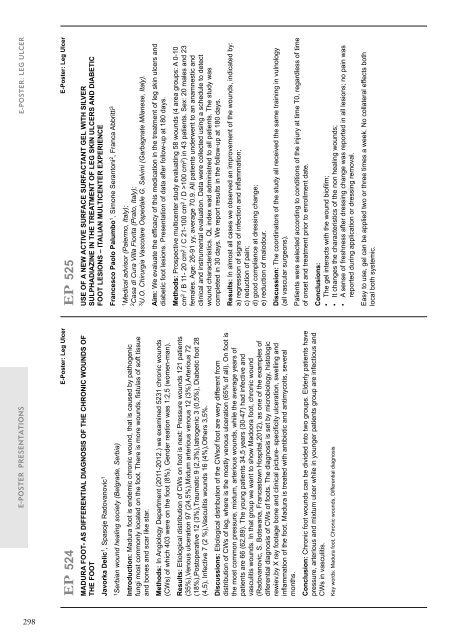Create successful ePaper yourself
Turn your PDF publications into a flip-book with our unique Google optimized e-Paper software.
E-POSTER PRESENTATIONS<br />
EP 524<br />
E-Poster: Leg Ulcer<br />
Madura foot- as differential diagnosis of the chronic wounds of<br />
the foot<br />
Javorka Delic 1 , Spasoje Radovanovic 1<br />
1 Serbian wound healing society (Belgrade, Serbia)<br />
Introduction: Madura foot is endemic chronic wound, that is caused by pathogenic<br />
fungi most commonly located on the foot. There is more wounds, fistulas of soft tissue<br />
and bones and scar like star.<br />
Methods: In Angiology Department (2011-2012.) we examined 5231 chronic wounds<br />
(CWs) of which 403 were on the foot (8%). Gender reation was 1:2,5 (women-man).<br />
Results: Etiological distribution of CWs on foot is next: Pressure wounds 121 patients<br />
(35%),Venous ulceration 97 (24,5%),Mixtum arterious venous 12 (3%),Arterious 72<br />
(18%),Postoperative 12 (3%),Traumatic 9 (2,3%),Iatrogenic 3 (0,5%), Diabetic foot 28<br />
(4,5), Infective 7 (2 %),Vasculitis wounds 16 (4%),Others 3,5%.<br />
Discussions: Etiological distribution of the CWsof foot are wery different from<br />
distribution of CWs of leg, where is the mostly venous ulceration (65% of all). On foot is<br />
the most common pressure, mixtum, arterious wounds, while the average years of<br />
patients are 66 (62,89). The young patients 34,5 years (30-47) had infective and<br />
vasculitis wounds. In that group we want to show Madoora foot, chronic wound<br />
(Radovanovic, S. Botswana, Francastown Hospital,2012), as one of the examples of<br />
diferential diagnosis of CWs of foots. The diagnosis is set by microbiology, histologic<br />
rewiev,by X ray footage bone and clinical picture- specificity ulceration, swelling and<br />
inflammation of the foot. Madura is treated with antibiotic and antimycotis, several<br />
months.<br />
Conclusion: Chronic foot wounds can be divided into two groups. Elderly patients have<br />
pressure, arterious and mixtum ulcer while in younger patients group are infectious and<br />
CWs in vasculitis.<br />
Key words: Madura foot, Chronic wounds, Differential diagnosis<br />
E-POSTER: LEG ULCER<br />
EP 525<br />
E-Poster: Leg Ulcer<br />
USE OF A NEW ACTIVE SURFACE SURFACTANT GEL WITH SILVER<br />
SULPHADIAZINE IN THE TREATMENT OF LEG SKIN ULCERS AND DIABETIC<br />
FOOT LESIONS – ITALIAN MULTICENTER EXPERIENCE<br />
Francesco Paolo Palumbo 1 , Simone Serantoni 2 , Franca Abbritti 3<br />
1 Medical advisor (Palermo, Italy);<br />
2 Casa di Cura Villa Fiorita (Prato, Italy);<br />
3 U.O. Chirurgia Vascolare Ospedale G. Salvini (Garbagnate Milanese, Italy).<br />
Aim: We evaluate the efficacy of this medication in the treatment of leg skin ulcers and<br />
diabetic foot lesions. Presentation of data after follow-up at 180 days.<br />
Methods: Prospective multicenter study evaluating 58 wounds (4 area groups: A 0-10<br />
cm 2 / B 11- 20 cm 2 / C 21-100 cm 2 / D >100 cm 2 ) in 43 patients. Sex: 20 males and 23<br />
females. Age: 26-91 yy, average 70.9. All patients underwent to an anamnestic and<br />
clinical and instrumental evaluation. Data were collected using a schedule to detect<br />
wound characteristics. QL index wad administred to all patients. The study was<br />
completed in 30 days. We report results in the follow-up at 180 days.<br />
Results: In almost all cases we observed an improvement of the wounds, indicated by:<br />
a) regression of signs of infection and inflammation;<br />
c) reduction of pain;<br />
d) good compliance at dressing change;<br />
e) reduction of malodour.<br />
Discussion: The coordinators of the study all received the same training in vulnology<br />
(all vascular surgeons).<br />
Patients were selected according to conditions of the injury at time T0, regardless of time<br />
of onset and treatment prior to enrollment date.<br />
Conclusions:<br />
• The gel interacts with the wound biofilm;<br />
• It changes the characteristics of the non healing wounds;<br />
• A sense of freshness after dressing change was reported in all lesions; no pain was<br />
reported during application or dressing removal.<br />
Easy to use, gel can be applied two or three times a week. No collateral effects both<br />
local both systemic.<br />
298






